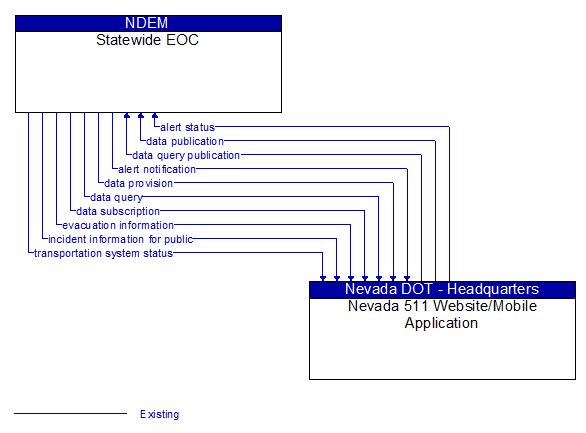Interface: Statewide EOC - Nevada 511 Website/Mobile Application

Architecture Flow Definitions
alert notification (Existing) Applicable ITS Standards
Notification of a major emergency such as a natural or man–made disaster, civil emergency, or child abduction for distribution to the public. The flow identifies the alert originator, the nature of the emergency, the geographic area affected by the emergency, the effective time period, and information and instructions necessary for the public to respond to the alert. This flow may also identify specific information that should not be released to the public.
alert status (Existing) Applicable ITS Standards
Information indicating the current status of the emergency alert including identification of the traveler and driver information systems that are being used to provide the alert.
data provision (Existing) Applicable ITS Standards
Data provision provides the source material for a publish–subscribe or query–retrieval data distribution scheme. This is the 1 of the 1:N data distribution architecture. This flow is a super–flow; it does not define data elements but is inclusive of any flow implemented using publish–subscribe or query–retrieval methods.
data publication (Existing) Applicable ITS Standards
Data publication includes those dialogs necessary to satisfy the publication portion of a data distribution architecture. The information content varies widely based on available content and the subscription, but it generally includes information on the state of transportation system operations including traffic and road conditions, advisories, incidents, transit service information, weather information, parking information, and other related data.
data query (Existing) Applicable ITS Standards
Data query includes those dialogs necessary to determine what data is available for and also submit a query for near–term response.
data query publication (Existing) Applicable ITS Standards
Data query publication includes those dialogs necessary to satisfy the response portion of a query–response action using the data distribution architecture. The information content varies widely based on available content and the query, but it generally includes information on the state of transportation system operations including traffic and road conditions, advisories, incidents, transit service information, weather information, parking information, and other related data.
data subscription (Existing) Applicable ITS Standards
Data subscription includes those dialogs necessary to determine what data is available for subscription/query, and also the dialogs necessary to create or modify data subscriptions/queries.
evacuation information (Existing) Applicable ITS Standards
Evacuation instructions and information including evacuation zones, evacuation times, and reentry times.
incident information for public (Existing) Applicable ITS Standards
Report of current desensitized incident information prepared for public dissemination.
transportation system status (Existing) Applicable ITS Standards
Current status and condition of transportation infrastructure (e.g., tunnels, bridges, interchanges, TMC offices, maintenance facilities). In case of disaster or major incident, this flow provides an assessment of damage sustained by the surface transportation system including location and extent of the damage, estimate of remaining capacity and necessary restrictions, and time frame for repair and recovery.